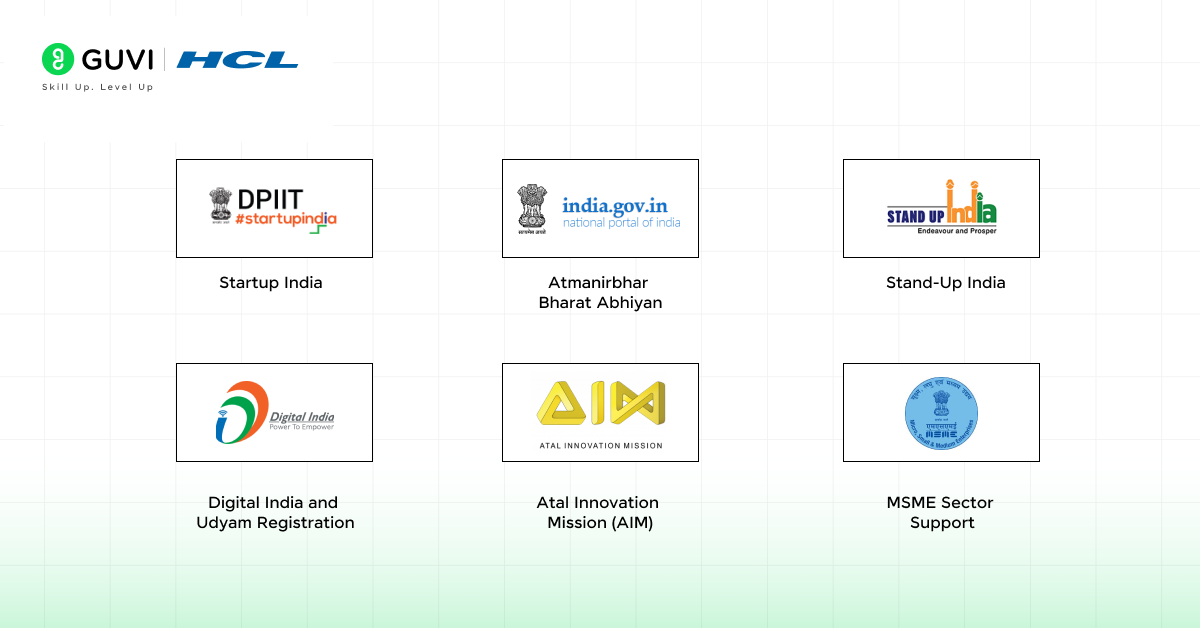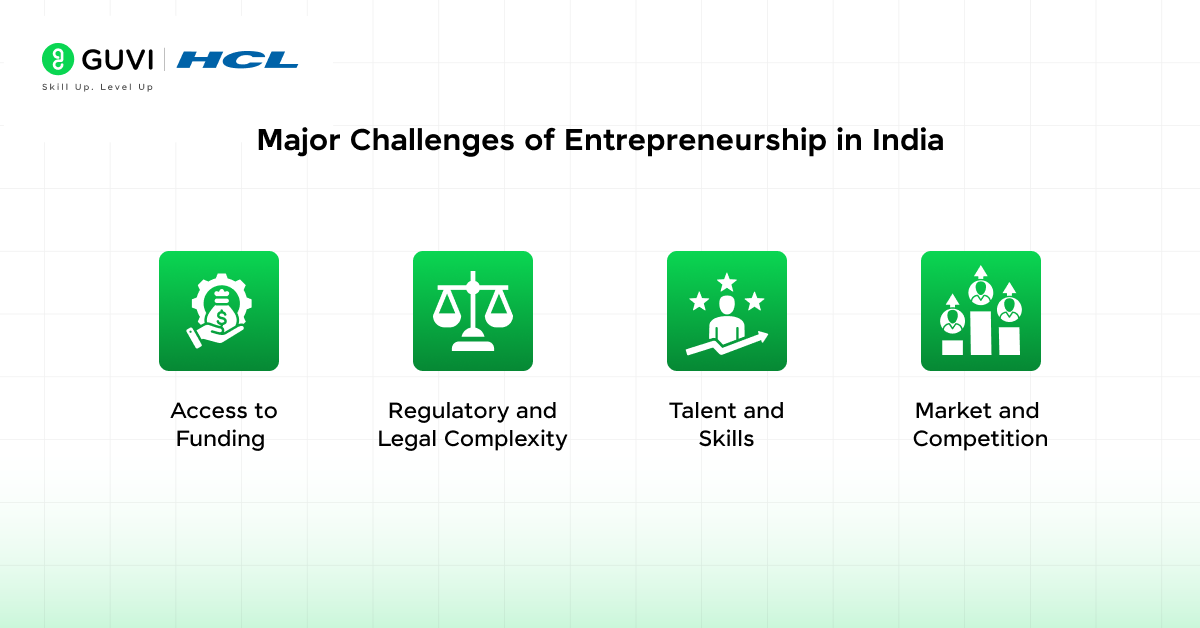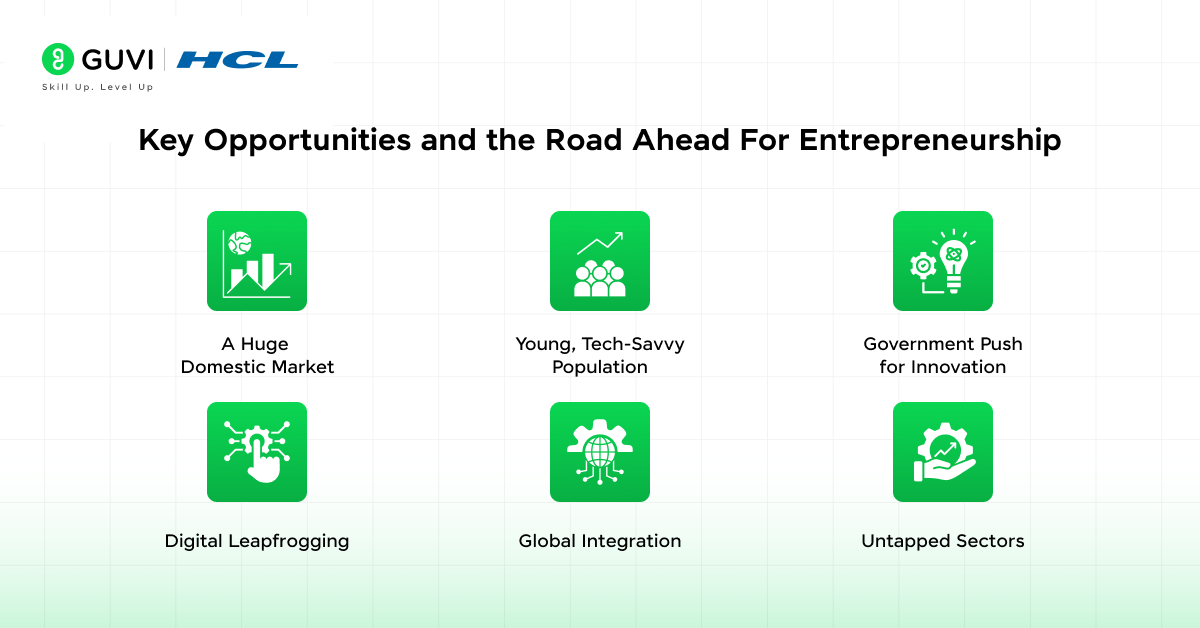
Entrepreneurship Development in India: A Know-it-All Guide
Oct 08, 2025 5 Min Read 1823 Views
(Last Updated)
Have you ever looked around your city or village and thought, “This could be done better”? That instinct, to solve a problem, to improve what exists, is often the seed of entrepreneurship.
In India, where over a billion people live with diverse needs and immense creativity, entrepreneurship isn’t just a career path; it’s becoming a powerful engine of economic and social transformation. But what does it take to start something, and what is the state of entrepreneurship development in India today? What support is available? And where are the real opportunities and the roadblocks?
Let’s explore entrepreneurship development in India, the current landscape, and what it takes to build something meaningful in this dynamic ecosystem.
Table of contents
- India’s Current Entrepreneurship Landscape and Trends
- Government Initiatives and Schemes
- Startup India (Launched in 2016)
- Atmanirbhar Bharat Abhiyan (Self-Reliant India Mission)
- Stand-Up India
- Digital India and Udyam Registration
- Atal Innovation Mission (AIM)
- MSME Sector Support
- Entrepreneurship Development in India
- Scale and Growth
- Sectoral Shifts
- Digital Infrastructure
- Major Challenges of Entrepreneurship in India
- Access to Funding
- Regulatory and Legal Complexity
- Talent and Skills
- Market and Competition
- Key Opportunities and the Road Ahead For Entrepreneurship
- Conclusion
- FAQs
- What is Startup India, and who can benefit?
- How do MSMEs register and what benefits do they get?
- What funding options are available for early-stage startups?
- What are the major challenges facing entrepreneurs in India?
- How is the government promoting entrepreneurship in smaller towns?
India’s Current Entrepreneurship Landscape and Trends
India’s entrepreneurial landscape has undergone a dramatic transformation over the past decade. The government estimates there are now over 1.59 lakh DPIIT-recognized startups nationwide, making India the third-largest startup ecosystem globally.
These range from tech-focused ventures to social enterprises, spanning technology, manufacturing, agriculture, healthcare, and more. Cities like Bengaluru, Mumbai, and Delhi NCR lead the way, but smaller hubs and even rural districts are emerging as innovation centers.
Iconic companies such as Zomato, Nykaa, and Ola exemplify this shift from job-seeking to job-creating, showcasing how Indian entrepreneurs tackle local problems with global ambition. A recent study found that startups have contributed about 10–15% of India’s GDP growth since 2016, highlighting their economic impact.
Government Initiatives and Schemes

India has made remarkable strides in building a supportive ecosystem for entrepreneurs, thanks largely to proactive government policies and schemes. The goal has been to reduce red tape, improve access to capital, and foster innovation across sectors. Let’s look at some of the major national-level initiatives that are shaping entrepreneurship development in India.
1. Startup India (Launched in 2016)
Startup India is a flagship initiative designed to nurture startups by providing a range of benefits, from tax exemptions to simplified compliance and access to funding. Startups that are less than 10 years old, privately held, and with annual turnover under ₹100 crore are eligible under the scheme.
Key benefits include:
- Three-year tax holiday under Section 80-IAC
- Fast-track patent filing and 80% rebate on patent costs
- Self-certification under labor and environmental laws
- Startup India Seed Fund Scheme (SISFS) offering up to ₹50 lakh for MVPs and prototyping
- Fund of Funds for Startups (FFS) with a corpus of ₹10,000 crore for early-stage VC funding
2. Atmanirbhar Bharat Abhiyan (Self-Reliant India Mission)
Launched in 2020 during the COVID-19 pandemic, Atmanirbhar Bharat Abhiyan aims to boost local manufacturing, innovation, and entrepreneurship.
- A ₹3 lakh crore collateral-free loan scheme was introduced for MSMEs
- Production Linked Incentive (PLI) schemes were launched for electronics, pharmaceuticals, and manufacturing
- Push for digital adoption and local solutions to reduce import dependency
This mission helped empower Indian startups to build for India and the world, creating a culture of resilience and self-reliance.
3. Stand-Up India
Stand-Up India initiative promotes entrepreneurship among underrepresented groups, especially SC/ST individuals and women.
- Provides bank loans ranging from ₹10 lakh to ₹1 crore
- Targets greenfield projects in manufacturing, services, and trading sectors
- Helps bridge credit gaps for first-time entrepreneurs from marginalized communities
4. Digital India and Udyam Registration
The Digital India mission plays a crucial role in enabling digital tools for startups. It includes initiatives like Aadhaar, UPI, DigiLocker, and eSign, all of which simplify identity verification, payments, and digital onboarding.
Udyam Registration, launched in 2020, replaces Udyog Aadhaar and streamlines MSME registration online using PAN and Aadhaar. Over 4.7 crore MSMEs have already registered, enabling them to:
- Avail priority sector lending
- Get access to government tenders and subsidies
- Benefit from collateral-free loans under CGTMSE (Credit Guarantee Scheme for MSMEs)
Suggested Read: Entrepreneurship Projects: Ideas, Types, and Getting Started
5. Atal Innovation Mission (AIM)
Run by NITI Aayog, AIM is focused on building a culture of innovation and entrepreneurship at the grassroots level.
- Atal Tinkering Labs in schools to foster early-stage innovation
- Atal Incubation Centers (AICs) offer infrastructure, mentoring, and funding for startups
- Programs like ARISE-ANIC support MSME research and innovation
6. MSME Sector Support
India’s vast MSME (Micro, Small & Medium Enterprise) sector is central to entrepreneurship. As of mid-2024, 4.78 crore MSMEs were registered via the government’s Udyam portal, collectively employing over 20.7 crore people. Recognizing this, the government introduced multiple measures for MSMEs:
- Collateral-Free Credit: Loans up to ₹5 crore are now available with up to 85% government guarantee under the CGTMSE program. This makes bank finance easier for small firms.
- Self-Reliant India Fund: A ₹50,000 crore fund (with ₹10,000 cr from the budget) was set up to infuse equity into MSMEs, helping them expand.
- Ease of Doing Business: Simplified Udyam registration (replacing older filings) and inclusion of retail/wholesale trades under MSMEs streamline compliance. Government procurement rules were relaxed (no global tender restrictions for contracts under ₹200 crore) to favor local enterprises.
- Skill and Formalization: Programs like the new Udyam Assist platform help informal micro-enterprises formalize and access credit. The PM Vishwakarma scheme (launched Sept 2023) provides training and financial support to traditional artisans and tradespeople (18 crafts).
These MSME-focused schemes complement the Startup initiatives, ensuring both high-tech ventures and traditional small businesses can grow.
Find out: Mastering the Fundamentals of Entrepreneurship
Entrepreneurship Development in India

Several broad trends help in the entrepreneurship development in India today:
1. Scale and Growth
In the last decade, over 120,000 startups have been created, and India now has the world’s third-highest number of unicorns (startups valued over $1B).
By early 2025, recognized startups grew from just 500 (in 2016) to nearly 160,000. This boom has generated about 16.6 lakh new jobs.
Although growth has been fastest in IT-led firms, noteworthy numbers have emerged in finance, healthcare, e-commerce, and new areas like climate tech.
2. Sectoral Shifts
Technology-led sectors remain hot.
- Fintech innovations (digital payments, neobanks, lending platforms) are exploding – the fintech market is projected to hit ~$150 billion by 2025.
- Agritech is surging as startups apply IoT sensors, AI analytics, and supply-chain solutions to farming; with rising rural incomes and government programs (e.g,. PM-KISAN, Agri Infra funds), this sector could reach ~$24 billion soon.
- Healthtech took off during Covid, and telemedicine and diagnostic startups raised about $1.5 billion in 2023 and continue growing rapidly.
- Edtech is expanding beyond metros, creating local-language learning apps and vocational platforms; the market may reach ~$10.4 billion by 2025.
Similarly, sustainability and clean energy are key trends. India’s renewable targets (500 GW by 2030) and programs like PM-KUSUM (solar pumps for farmers) are spawning many greentech ventures.
3. Digital Infrastructure
India’s digital public infrastructure is a boon. A massive growth in internet access (from ~250 million users in 2014 to over 954 million by March 2024) means entrepreneurs can reach customers almost anywhere.
Unified tools like Aadhaar and UPI have formalized even mom-and-pop businesses. Initiatives like the Open Network for Digital Commerce (ONDC) aim to link sellers with markets nationwide.
As mobile connectivity spreads, more rural areas become accessible, opening new markets for apps and online services.
Discover: What is the Scope of Entrepreneurship in 2025?
Major Challenges of Entrepreneurship in India

Despite the momentum, Indian entrepreneurs must navigate hurdles. A recent analysis highlights several key challenges:
1. Access to Funding
While large rounds attract headlines, many startups struggle for early-stage capital. The ecosystem has relatively few seasoned angel investors and venture funds compared to mature markets.
Complex regulations (such as FDI limits and the infamous “angel tax” on equity funding) can deter investment. Banks are often risk-averse, even with schemes like CGTMSE.
2. Regulatory and Legal Complexity
Startups face a maze of rules. Incorporating a company involves choosing a legal structure (and related taxes), and then complying with filings, audits, and licenses. Many entrepreneurs find the legal framework confusing and burdensome.
Inconsistent enforcement and slow approval processes add delays. For example, the requirement that startups file complex annual reports can be overwhelming for a tiny team.
Borrowing from abroad also means navigating FEMA and RBI rules, which can slow fundraising. Although reforms are underway (like simplified compliance for startups), the regulatory burden is still cited by entrepreneurs as a pain point.
3. Talent and Skills
India has a young, educated population, but startups often report difficulty finding specialized talent (e.g., for AI, biotech, niche manufacturing). Many students still aim for traditional corporate careers or government jobs.
Despite programs like Skill India, vocational and technical training gaps persist. The cultural bias favoring secure jobs can make it harder for entrepreneurs to build teams.
4. Market and Competition
Breaking into even domestic markets is tough. Startups compete with entrenched incumbents and sometimes face price-sensitivity. Expanding internationally adds complexity (different regulations, standards).
Finding the first customers (especially for novel products) can be slow, and many startups pivot multiple times before scaling.
In short, Indian entrepreneurs must be resilient and resourceful. Yet many of these challenges are being addressed over time through regulatory reforms, more investor activity, and ecosystem-building programs.
Discover: Top 9 Types of Entrepreneurship
Key Opportunities and the Road Ahead For Entrepreneurship

Despite challenges, the opportunity level is vast:
- A Huge Domestic Market: With 1.4+ billion people, India offers one of the world’s largest consumer markets. Rising incomes and urbanization mean demand for goods and services across categories.
- Young, Tech-Savvy Population: Over 65% of Indians are under 35. This demographic dividend means a ready base of innovators, customers, and workforce. More young people now view entrepreneurship as a career.
- Government Push for Innovation: India’s goal to become a $5 trillion economy and a “developed nation” by 2047 places innovation front and center.
- Digital Leapfrogging: India often skips older technologies and adopts the latest directly. The rapid spread of smartphones and digital payments means even rural entrepreneurs can innovate.
- Global Integration: Indian startups are increasingly eyeing international markets. Many serve not just India but also other emerging economies. Government programs under the G20 and BRICS encourage cross-border startup collaboration.
- Untapped Sectors: Numerous social and environmental challenges in India also create business opportunities. Startups in clean energy, sustainable agriculture, healthcare access, education for low-income families, and women’s empowerment can both generate profit and address critical needs.
The startup ecosystem in India is richer and more supportive than ever before, yet still growing.
If you want to learn more about Entrepreneurship, along with a set of Full-stack skills, then consider enrolling in HCL GUVI’s IIT-D Certified Appreneur Program – Become an Entrepreneur with Full Stack Skills, which starts from basic concepts like OOPS and ends with building a product and deploying it. The course also helps you with the means to get an investor for funding and a globally recognized certification by the end.
Conclusion
In conclusion, the development of entrepreneurship in India is vibrant, diverse, and filled with promise. From government schemes and digital infrastructure to the rise of young, tech-savvy innovators, the conditions are more favorable than ever for launching a startup or small business. Yet, challenges like funding gaps, regulatory complexity, and talent shortages remain real.
By staying informed of schemes like Startup India, tapping into new trends and learning from emerging best practices, you can find ways to make an impact. And remember: every big startup idea starts with observing a need and daring to solve it.
FAQs
1. What is Startup India, and who can benefit?
Startup India is a government initiative launched in 2016 to support new ventures through simplified compliance, tax exemptions, incubation, and funding support under DPIIT recognition. It’s open to private firms, LLPs, or partnership businesses under 10 years old with annual turnover under ₹100 crore.
2. How do MSMEs register and what benefits do they get?
MSMEs register via the Udyam portal (since 2020), replacing Udyog Aadhaar with Aadhaar and PAN verification. Over 4.77 crore MSMEs are registered, allowing access to collateral‑free loans under CGTMSE, subsidies, and protection under the MSMED Act.
3. What funding options are available for early-stage startups?
Startups can access early-stage capital through the Seed Fund Scheme (up to ₹50 lakh), the Credit Guarantee Scheme, and the ₹10,000 crore Fund of Funds under Startup India. Additional MSME-focused guarantee schemes and state incubation centers also provide seed grants and mentoring.
4. What are the major challenges facing entrepreneurs in India?
Key challenges include limited early-stage funding, regulatory complexity, and cumbersome legal compliance processes. Infrastructure gaps (especially in rural regions) and difficulty attracting skilled talent also hinder growth.
5. How is the government promoting entrepreneurship in smaller towns?
Initiatives like Startup India’s district-level hubs, Atal Incubation Centres, and state-level programs (e.g., Rajasthan’s iSTART) are expanding support beyond metros. These provide local entrepreneurs with mentorship, seed funding, co-working spaces, and market access




































Did you enjoy this article?